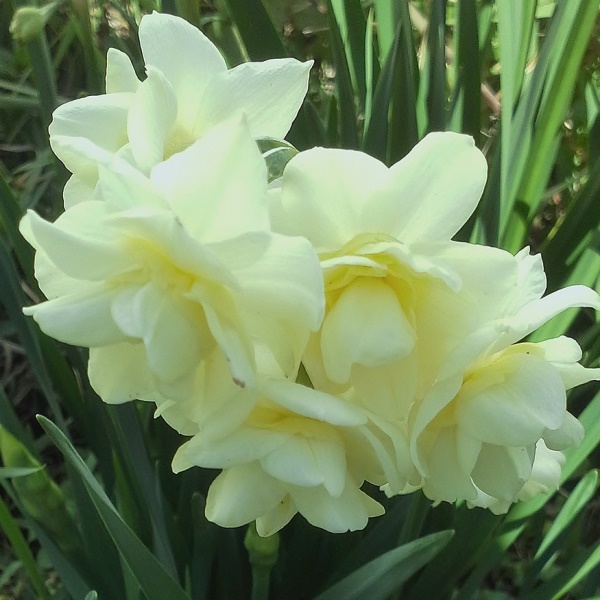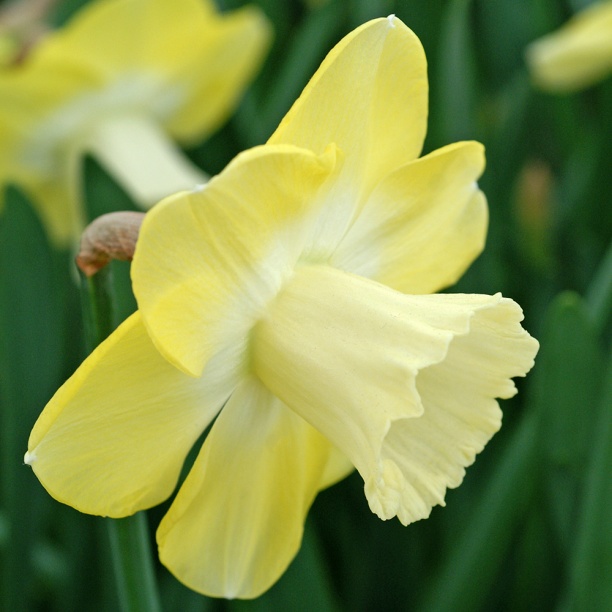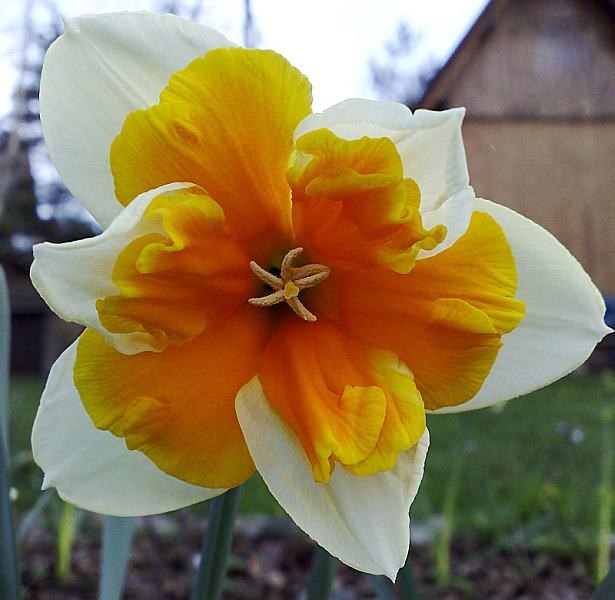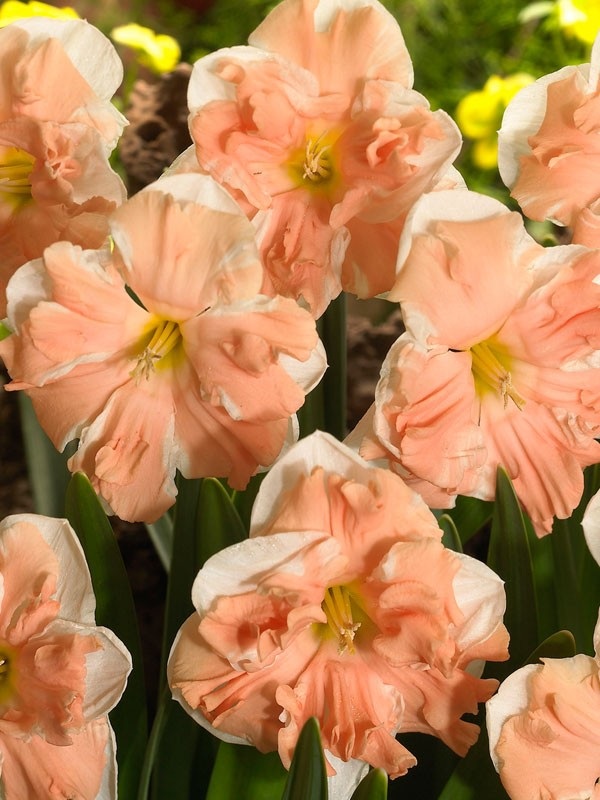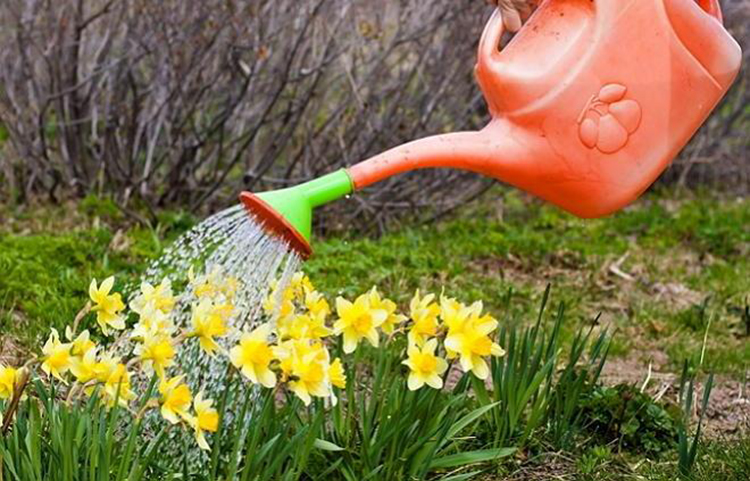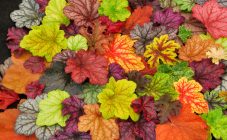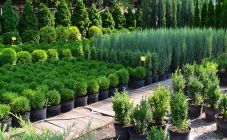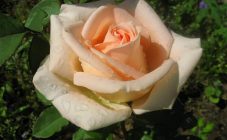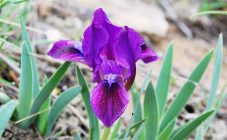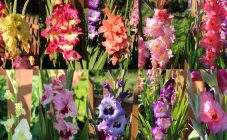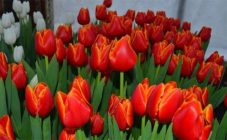Content:
Narcissus is a monocotyledonous flowering plant belonging to the Amaryllidaceae family. One of the most common flowering plants among domestic flower growers, the varietal variety is so large that it is already impossible to say the exact figure. A characteristic feature of the culture is the presence of ribbon-like leaves of various widths, as well as bulbs. Inflorescences form at the top of a leafless stem, which is covered with a membranous membrane.
Popular varieties of daffodils. Short description
Depending on the variety, plants can be multi-flowered or single. The perianth is characterized by a petal-shaped form, includes six components. Visually, the flowers are a lobed or one-piece bell, which has a trihedral lower ovary and six stamens.
The flower grows most readily in Europe, but is also common in Mediterranean countries. There is a wide variety of varieties, the main ones are:
- Narcissus Replete. Narcissus Replit reproduces vegetatively. It perfectly tolerates direct sunlight, and lush bloom can be contemplated in conditions of shade and partial shade. Several broad flat leaves grow from each stem, have a rich green color. Several buds can form on one peduncle, flowers of a pale pink color are formed, the terry edging has a peach tint. Plant height can reach 50 cm. They are actively used for landscaping garden plots.
- Narcissus Acropolis is a white flower that was once brought from the Iberian Islands. Readily grows on mountain slopes, especially in areas with large vegetation, including weeds. In the wild, it can be found in pine forests and in places with acidified soil. An adult plant can reach a height of 35 cm. It propagates in a bulbous way, they are characterized by a spherical shape and a diameter of no more than 4 cm. A large number of green thin leaves are formed on the stem. Begins to grow actively in mid-spring, flowering duration is no more than 10 days.
- Narcissus Yellow Chirfulness was brought to us from France and southern Italy. Readily grows on the southern slopes of the Caucasus Mountains. As the name suggests, the flowers have a deep yellow color, small growth. An adult plant can reach no more than 30 cm. Propagated by bulbs, their diameter does not exceed 5 cm, they are characterized by a round and oval shape. The diameter of a blossoming flower averages 4 cm. The variety blooms, as a rule, in mid-May, flowering duration 15 days.
- Narcissus Erlichir was brought back in the distant 1520 from western Italy. A characteristic feature of the variety is not only a pale pink color, but also its height, it can reach 45 cm. The leaves are characterized by a dark green color, they are wider than that of other varieties. During flowering, one flower forms on the stem. Propagated by bulbs, the bulbs of adult plants reach a diameter of 5 cm. The plant blooms with the arrival of May. To preserve the flower, you need to dig up the bulbs and keep them in a dark place until warm.
- Narcissus Cassata belongs to the cyclamen group. The variety was bred in 1584, brought to Russia from Germany and the Caucasus mountains.The plant is short, as a rule, it does not exceed 25 cm. One inflorescence is formed on the peduncle, the bud is strongly lowered to the ground. The color is bright yellow, the petals are raised up.
- Narcissus Obdam belongs to the terry group of plants. During flowering, it exudes a pleasant, refined aroma. Each flower is formed on a separate pedicel, the color is beige. The buds are impressive in size, when opened, their diameter can reach 10 cm.The height can reach half a meter. Duration of flowering is no more than 10-12 days.
- Narcissus Tahiti. Narcissus Tahiti is the owner of large double inflorescences, the height of which reaches 10 cm. The main color of the petals is yellow. Inside is a red-orange crown. In the phase of active growth, the plant reaches 35 cm in height. It has dark green leaves that form below the buds. The variety reproduces vegetatively, grows in personal plots. Prefers moist soil and sunlight. By the end of flowering, the color saturation dims, a pleasant aroma does not cease to exude.
- Narcissus Avalon was brought from the mountains. In the wild, the flower grows near water bodies and on elevations. The culture is growing rapidly, he likes the neighborhood with chestnut trees. For lush flowering, the flower must be provided with the optimal amount of moisture. The plant reaches a height of half a meter. Propagated by bulbs, which are characteristic of the shape of a chicken egg. One bush is capable of producing no more than 5 flat leaves. They are characterized by a rich green color. The flowers are white, the core is bright yellow. The diameter of the blossoming flower reaches 6 cm, the duration of flowering is 12 days.
- Terry narcissus Rip Van Winkle can grow both in open areas and among trees. The maximum height that a plant can reach is 30 cm. It grows in moist and fertile soil, does not tolerate drought well. Has wide leaves. The color of the flowers is deep yellow. Soon after flowering, the plant is dug up and stored in a dry, dark place, planted shortly after winter.
- Narcissus Golden Ducat belongs to the Large-crowned group, was obtained in 1967 in Northern Ireland. Perianth lobes have an obovate shape, have a snow-white color. The peduncles are strong. The variety is resistant to a large number of diseases and pests.
- Narcissus Irene Copeland belongs to the old varieties belonging to the group of terry. The perianth is white, broadly elliptical. Korna has a terry dusting, pale pink color. Peduncles are fragile, the flower is rather heavy, for this reason it often lays down.
- Narcissus Carlton was bred back in 1948. The variety belongs to the group of split-crown. Each perianth lobe has a snow-white color, the crown has the shape of a star, often dissected crowns. There is a characteristic yellow stripe in the center of each ray. Flowering duration is average, usually no more than 10 days.
- Narcissus Orangerie - a variety belonging to the small-crowned group, was obtained in the Netherlands in 1938. The color of the perianth is yellow. The crown has wavy edges, rich yellow color. This variety has one significant drawback - it is affected by pests and diseases.
- Las Vegas daffodil is arguably one of the best mid-flowering varietal varieties. Possesses attractive decorative properties. It can reach a height of 25 to 40 cm. The perianth lobes are characterized by oval shapes with pointed ends, the color is milky white. Flowers are arranged horizontally. Duration up to three weeks, the active growth phase begins in mid-spring. Grows in sunny areas and in partial shade conditions.
- Daffodil Flyer is a fairly effective variety, the inflorescences are snow-white in color.The crown is expressive, has wavy edges, at each phase of its growth it changes its color: at the initial stage, the shade is rich peach, then it gradually fades.
- Narcissus Bridal Crown is an American cultivar that was bred in 1960. Each component of the perianth has an elliptical shape and a snow-white color. The crown is wavy, gradually changing its color: at the initial stage, it is bright orange with a pink edge, at the end, orange tones are replaced by pink. Flowering duration is average.
- Narcissus Epricot Whirl is very beautiful and durable. The color of the inflorescences is white with a slight yellowish tint. The crown is rather large with jagged edges, the color is bright yellow. Flowering duration is average.
Planting and leaving
Narcissus belongs to the perennial group. They can grow in partial shade, but still prefer sunny areas, average winter hardiness. Plants are unpretentious in care and planting, they do not take much time from the agronomist. Grows willingly on ordinary garden soil, loves moderate moisture.
A month before the expected date of planting, mineral and organic fertilizers, as well as peat and sand, must be applied to the soil. The most favorable time for planting is the second or third decade of September. This gives the bulbs the opportunity to root in a new location and adapt. Also, the crop can be grown in a pot. Shortly before planting, the bulbs must be treated with a disinfectant, for example, a weak solution of manganese. The optimum temperature range for the development of a perennial is + 18-22 degrees.
Daffodil care
The grooming does not include any unusual requirements. Basic care and regular application of mineral and organic fertilizers to the soil are enough (the optimal frequency for the growing season is 3 times). The first feeding is done shortly after the first shoots appear, the second - during the formation of buds and the third - soon after flowering. There is no need to fertilize after flowering.
For wintering and reproduction, it is necessary to use only high-quality and healthy planting material. The bulbs should be firm to the touch and large in size. The color of the cover scales is white or yellow. Their obvious peeling may indicate the course of various fungal diseases.
The flowering period is usually long, from April to June. When growing crops in the northern regions of the country, it is necessary to cover the plants before the onset of frost.
Diseases and pests
Daffodils, unfortunately, are prone to a large number of diseases and pest attacks. The most common pathologies:
- Sclerocial rot;
- A serious illness is fusarium.
As for insects, the plant is susceptible to attack by such pests:
- Thrips;
- Nematodes are stem, bulbous and root;
- Bulbous and narcissus flies.
Daffodils are attractive bulbous perennials with good decorative properties. Due to the great abundance of varieties and species, every agronomist has the opportunity to create an incredible flower arrangement in the flower beds.

